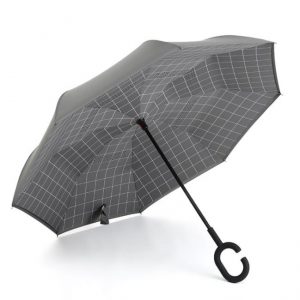Windproof umbrella technology has evolved over the years to improve the performance and durability of umbrellas in windy conditions. Here are some key aspects of windproof umbrella technology:
- Frame Material and Construction: Windproof umbrellas typically use advanced materials like fiberglass, carbon fiber, or high-quality metals in their frames. These materials offer flexibility, strength, and resistance to bending or breaking in strong winds. Some umbrellas also feature reinforced joints and tips to enhance the overall frame stability.
- Double-Canopy Design: Many windproof umbrellas incorporate a double-canopy design, where two layers of fabric overlap each other. This design allows wind to pass through the gaps between the layers, reducing wind resistance and preventing the umbrella from flipping inside out.
- Vented Canopy: Vented canopies are a common feature in windproof umbrellas. These canopies have strategically placed vents that allow wind to pass through, thereby reducing pressure on the umbrella and increasing its stability in gusty conditions.
- Aerodynamic Shape: Some windproof umbrellas have an aerodynamic shape, designed to deflect wind rather than catching it. The streamlined design helps reduce the force of the wind on the umbrella, making it less likely to invert.
- Tensioning Systems: Certain windproof umbrella models use unique tensioning systems to add strength and support to the canopy and frame. These systems, such as Blunt Umbrella’s Radial Tensioning System, keep the fabric taut and prevent it from collapsing inwards during strong gusts.
- Wind Resistance Testing: Reputable windproof umbrella manufacturers subject their products to wind resistance testing. This involves testing the umbrella in wind tunnels or controlled wind conditions to determine its maximum wind resistance. Wind resistance ratings are often provided in miles per hour (mph) to indicate the umbrella’s performance in windy conditions.
- Water-Repellent Fabric: Windproof umbrellas often feature canopies made from water-resistant materials like high-density polyester or nylon. This not only provides protection against rain but also helps keep the umbrella lighter when wet.
- Automatic Open/Close Mechanism: Many windproof umbrellas come with an automatic open and close mechanism for quick and easy deployment. This feature allows users to open or close the umbrella with just the push of a button, making it convenient during sudden weather changes.
- UV Protection (Optional): Some windproof umbrellas may also offer additional features like UV protection to shield users from harmful sun rays on sunny days.
These advancements in windproof umbrella technology have resulted in stronger and more reliable umbrellas that can withstand adverse weather conditions, providing users with better protection and peace of mind during rainy and windy days.








